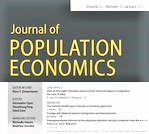A new paper published ONLINE FIRST in the Journal of Population Economics provides global evidence that the U-shaped happiness-age curve is everywhere.
Read more in:
Is happiness U-shaped everywhere? Age and subjective well-being in 145 countries
David G. Blanchflower
Published ONLINE FIRST. Forthcoming: Journal of Population Economics (2021), volume 34. FREE READLINK: https://rdcu.be/b7kyO
Also GLO Discussion Paper No. 530, 2020.
Watch also his related GLO Virtual Seminar presentation on Despair, Unhappiness and Age. Video of seminar.
GLO Fellow David G. Banchflower & Research Director GLO

Author Abstract: A large empirical literature has debated the existence of a U-shaped happiness-age curve. This paper re-examines the relationship between various measures of well-being and age in 145 countries, including 109 developing countries, controlling for education and marital and labor force status, among others, on samples of individuals under the age of 70. The U-shape of the curve is forcefully confirmed, with an age minimum, or nadir, in midlife around age 50 in separate analyses for developing and advanced countries as well as for the continent of Africa. The happiness curve seems to be everywhere. While panel data are largely unavailable for this issue, and the findings using such data largely confirm the cross-section results, the paper discusses insights on why cohort effects do not drive the findings. I find the age of the minima has risen over time in Europe and the USA.
Access to the newly published complete Volume 33, Issue 4, October 2020.
LEAD ARTICLE OF ISSUE 4:
Yun Qiu, Xi Chen & Wei Shi, Impacts of social and economic factors on the transmission of coronavirus disease 2019 (COVID-19) in China
Journal of Population Economics 33, 1127–1172 (2020). OPEN ACCESS
Over 21K journal downloads & over 60 Google Scholar cites as of September 10, 2020.

Ends;

